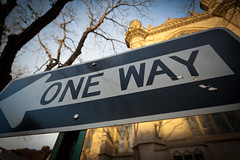 Downtown San Rafael must serve a dual purpose. On the one hand, it is the walkable urban core of Marin, a major center of retail, culture, religion, and office space. On the other hand, it is the gateway between Ross Valley and Highway 101, and it has turned two of its five east-west streets (Second and Third) into high-speed, one-way arterials for that purpose.
Downtown San Rafael must serve a dual purpose. On the one hand, it is the walkable urban core of Marin, a major center of retail, culture, religion, and office space. On the other hand, it is the gateway between Ross Valley and Highway 101, and it has turned two of its five east-west streets (Second and Third) into high-speed, one-way arterials for that purpose.
Though these streets are repellent to pedestrians and, therefore, retail, the one-way travel conversion allows speedy and efficient access to the freeway, so at least they function well as glorified on/off ramps.
So why are B, C, and D streets, which run north-south, one-way, too?
Stockton City Limits wrote about Stockton's one-ways and offered up Jeff Speck's rationale for converting back to two-ways:
One-ways harm downtown in several ways: First, as one-way streets are designed to get cars to their destination as fast as possible, increased automobile speeds create a more dangerous and uninviting environment for pedestrians. Second, one-way streets distribute traffic unevenly, negatively impacting surrounding commercial activity. Businesses along one-ways suffer from a lack of visibility as drivers can quickly speed by without even noticing that a business is there, or only drive by once a day, either on their way into work or on the way back home.
That last point - that businesses suffer - is especially true for businesses whose storefronts face away from oncoming traffic.
Now, Second and Third, unpleasant though they are, at least serve their (too-limited) purpose well. Traffic is heavy to and from Highway 101 along those routes. Folks who remember the one-way conversion some 40 years ago recall those roads as congested when they were two-way.
But the lettered streets are all pain with no gain. There's no improvement to traffic flow because there is almost no traffic flow to improve. In the meantime, all they do is hurt business, confuse visitors, and provide a raison d'être to the ugliest Do Not Enter sign in the city.